School Year of Core Vocabulary Words: AAC Resources for Month 1 (August) by Michaela Sullivan, Alisa Lego, & Beth Lytle
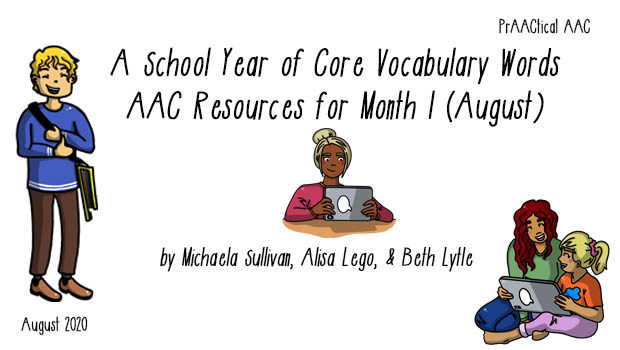
August may be on the way out but the words for this month are useful all throughout the year. The new Year of Core Words School Edition is in development and the plan is to get these monthly to you prior to the start of each month so that you can plan and prepare. Please bear with us for the first few posts as we get up to speed. Each of the monthly posts will highlight a selected set of words and a suggested order in which to teach them. You’ll also find resources, such as Activity Sheets for each word and data collection forms, and information on a key intervention strategy.
The series authors, Michaela Sullivan, Beth Lytle, and Alisa Lego, created an introduction that you may want to review before digging into this month’s target words. You can see that here.
Enjoy Month 1 of the School Year of Core Words!
A SCHOOL YEAR OF CORE WORDS
by Michaela Sullivan, Beth Lytle, & Alisa Lego
THE WORDS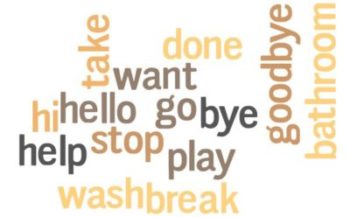
Level 1 words for August: I/me, hi/hello, bye/goodbye, help, stop, go, want, play, that, out, in, more, all done, bathroom, take a break, wash
The suggested sequence for implementation is listed below.
- Week 1: bye/goodbye, help, hi/hello, I/me
- Week 2: go, play, stop, want
- Week 3: in, more, out, that
- Week 4: all done, take a break

Level 2 words for August: us, had, meet, went, funny, outside, inside, better, beside, next to, run, hear, hang, okay, awesome, How are you?
The suggested order for these words is listed below.
- Week 1: had, meet, us, went
- Week 2: better, funny, inside, outside
- Week 3: beside, hear, next to, run
- Week 4: awesome, hang, how are you, okay
THE SYMBOLS
You can download grids with the symbols for this month’s words from the lists below. These handy tools can help us remember what words to focus on and be useful in our intervention and instruction. For aided language input, though, it’s best to model on the AAC system that the student uses. Watching us navigate those systems to use these words in context gives AAC learners valuable information about where symbols are located and how they can be combined with other symbols, among other things.
Level 1 Words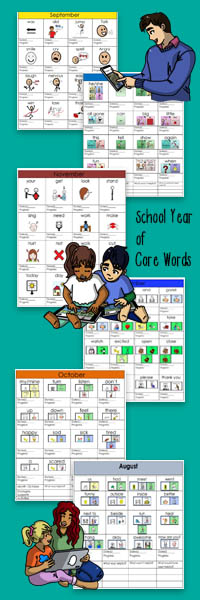
- Avaz
- CoughDrop
- LAMP Words for Life
- Wordpower 60 Basic
- Unity 45 Sequenced
- Unity 60 Sequenced
- Unity 84 Sequenced
- Blank Grid (add your own symbols)
Level 2 Words
- Avaz
- CoughDrop
- LAMP Words for Life
- Wordpower 60 Basic
- Unity 45 Sequenced
- Unity 60 Sequenced
- Unity 84 Sequenced
- Blank Grid (add your own symbols)
THE ACTIVITIES
These sets of Activity Sheets are divided into weeks and can be downloaded for easy access.
Activity Sheets for Level 1 Words
Activity Sheets for Level 2 Words
THE STRATEGY OF THE MONTH
This month’s key strategy is Aided Language Stimulation (ALS).
ALS is a researched-based approach to implementing and teaching individuals how to use their AAC systems by having the communication partner both speak and simultaneously point to the word or words they are expressing on the individual’s communication system. It is important to note that the communication partner does not have to find EVERY word expressed on the AAC device, in fact, start modeling 1-2 words beyond the level the individual is communicating. For example, if an individual is at the single word level, when targeting ‘more’, say ‘you want more’ and point to that same phrase on the individual’s communication system. This will assist in modeling the expansion of language and acquisition of vocabulary in natural or more instructional contexts.
We incorporated this strategy in all of our Activity Sheets surrounding the targeted core words. Until it becomes a habit, create intentional opportunities to practice this skill.
Please find the following additional resources on Aided Language Stimulation below. These resources will be helpful for individual learning and/or for team training.
Resources:
- Aided Language Stimulation Explained by Chris Bugaj
- Guide to ALS from Coughdrop
- Aided Language Stimulation with step-by-step directions from the AAC Institute (aacinstitute.org)
- Communication Tips & Strategies – Aided Language Stimulation (ALS) by the Autism Association of Western Australia
- Aided Language Stimulation Boards – Core Word Vocabulary Boards by Learning Language with ALS Board
- Do’s and Don’ts of AAC Modeling by AssistiveWare
- Aided Language Input with Kendal by AAC Chicks at Dynamic Therapy Associates
- Using Aided Language Input to Build Communication Opportunities! by Robin Parker and posted on January 27, 2014 on PrAACtical AAC
- Research Support for Aided Language Input by Carole Zangari and posted on PrAACtical AAC on May 31, 2018
DATA COLLECTION & ACCOUNTABILITY FORMS
Taking data to measure performance and keeping track of our own modeling behavior are two things we can do to strengthen our AAC teaching. Here are some forms that you can use to support those efforts.
About the School Year of Core Vocabulary Series Authors
 Michaela Sullivan is an SLP who specializes in the fields of AAC and AT. She currently works within the San Francisco Unified School District on the AAC Support Team where she supervises graduate students, works in a transition program and on special projects. Ms. Sullivan is also an AAC and AT Team member within the San Mateo Unified School District where she developed an AAC Mentorship program. Ms. Sullivan also has a private practice. She has been a presenter in the field of SLP and AAC at state and national conventions. She serves as a board member and volunteer for the Nika Project, providing services, supports, resources, training, and repurposed equipment for individuals with complex communication needs both locally and internationally.
Michaela Sullivan is an SLP who specializes in the fields of AAC and AT. She currently works within the San Francisco Unified School District on the AAC Support Team where she supervises graduate students, works in a transition program and on special projects. Ms. Sullivan is also an AAC and AT Team member within the San Mateo Unified School District where she developed an AAC Mentorship program. Ms. Sullivan also has a private practice. She has been a presenter in the field of SLP and AAC at state and national conventions. She serves as a board member and volunteer for the Nika Project, providing services, supports, resources, training, and repurposed equipment for individuals with complex communication needs both locally and internationally.
 Alisa Lego is a second-year graduate student and candidate for Master’s of Science in Speech, Language and Hearing Sciences at San Francisco State University. Alisa is specializing in AAC through San Francisco State University’s federally funded Project Building Bridges. Alisa is also a candidate for the Autism Spectrum Graduate Certificate. Through Project Building Bridges, she has joined the Nika project and is providing resources for individuals with complex communication needs both locally and across the globe. You can follow Alisa on Instagram at @newfriendscollective.
Alisa Lego is a second-year graduate student and candidate for Master’s of Science in Speech, Language and Hearing Sciences at San Francisco State University. Alisa is specializing in AAC through San Francisco State University’s federally funded Project Building Bridges. Alisa is also a candidate for the Autism Spectrum Graduate Certificate. Through Project Building Bridges, she has joined the Nika project and is providing resources for individuals with complex communication needs both locally and across the globe. You can follow Alisa on Instagram at @newfriendscollective.
 Beth Lytle is a second-year graduate student and candidate for Master’s of Science in Speech, Language and Hearing Sciences at San Francisco State University. Beth is specializing in AAC through San Francisco State University’s federally funded Project Building Bridges. Through Project Building Bridges, she has joined the Nika project and is providing resources for individuals with complex communication needs both locally and across the globe.
Beth Lytle is a second-year graduate student and candidate for Master’s of Science in Speech, Language and Hearing Sciences at San Francisco State University. Beth is specializing in AAC through San Francisco State University’s federally funded Project Building Bridges. Through Project Building Bridges, she has joined the Nika project and is providing resources for individuals with complex communication needs both locally and across the globe.
Filed under: Featured Posts, PrAACtical Thinking
Tagged With: A Year of Core Vocabulary Words, Education & Schools
This post was written by Carole Zangari



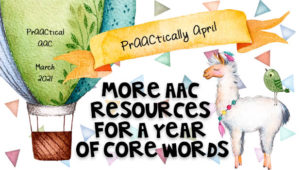
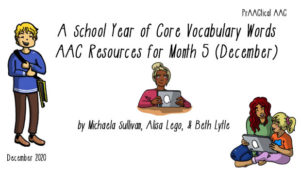
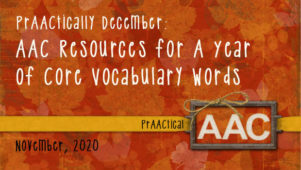
11 Comments
WOW! Thank you for all the hard work putting this together.
Thanks for stopping by to comment, Kim. Didn’t they do a terrific job?!
Oh my gosh! I am so excited for this! I teach 2nd-5th special education, focusing on kiddos with autism and ID. I just shared this page with a few others in my school who I think could use it. The fact that everything is all laid out, with engaging videos and stories and ideas for implementation is like a JACKPOT and saves me so much time! I am so grateful for this meaningful work, and have no doubt that the impact it will have on so many children will be immeasurable!
Beth, nothing could make us happier than to know that people like you find these resources useful. Teachers and clinicians are stretched so thin these days that having someone put together a thoughtful set of resources can make all the difference! Thanks for taking the time to comment and share your enthusiasm. I’d love it if you would reach out at some point in the future and let us know how it is going. 🙂
These are amazing! Thank you for all the fabuolous ideas!
Didn’t they do a terrific job?! Hours and hours of work go into each post.
This is an amazing resource. Thank you so much for sharing it with us for FREE! I am using many many of the ideas with my preschoolers, but I think they would be useful for any age.
We are so thrilled that people continue to find these resources helpful. Happy New Year! Michaela
I’m so excited to have these resources available. I’m getting ready for my new class next year, UTK-5th with multiple students using AAC. Thank you!
This is so amazing! Thank you.
I am looking for the complete site which is posted somewhere.
Please might you share the link with me?
I met your team at ASHA 2023 in Boston taking one of Dan P’s courses.
Thank you for this amazing site! I am a mama of an AAC user in addition to being an SLP. This site I have shared with my son’s educators and they love it. I am making interactive PrAACtical AAC kits to assist with his literacy skills due to his dislike of fine motor skills for home and for both of his schools, and of course for his peers too. There just isn’t anything out there to purchase for core word manipulatives (there are so many for sight words). This blog is also full of goodies to back up use of core words versus sight words for AAC users. Thank you so much for the free access. You are making a difference and giving voices to more AAC users.